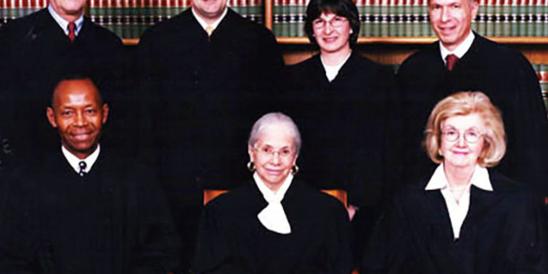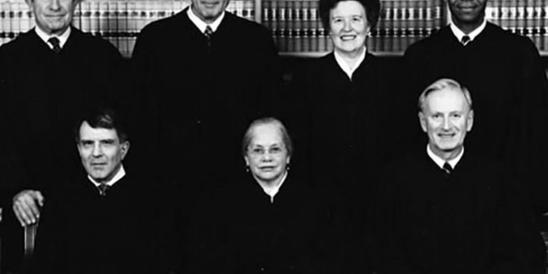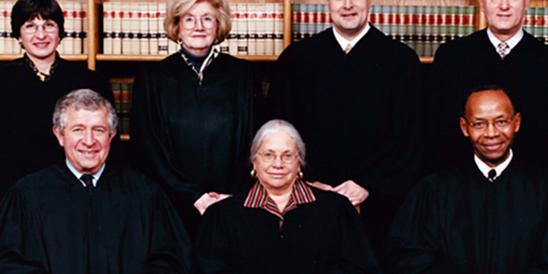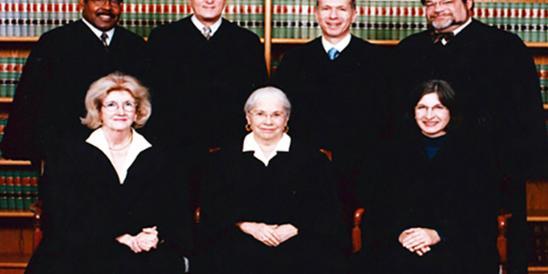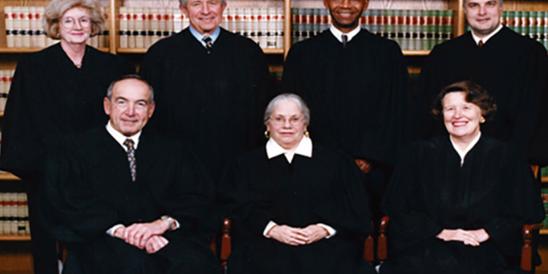
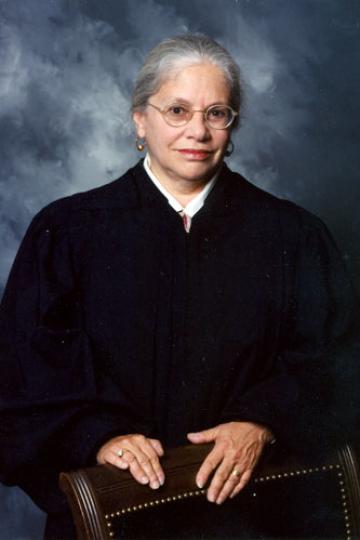
- Term: July 10, 1996 - Oct. 25, 2006
- Status: Retired
Introduction
Deborah Poritz took the most unlikely of routes to become the first female Chief Justice of New Jersey’s Supreme Court. The law was not her first profession, education was. Yet after leaving her position as a college professor and graduating from law school, Poritz continued to educate others by both word and deed. There’s little doubt that the appointment of Chief Justice Poritz is one of Governor Christine Todd Whitman’s proudest accomplishments.
Chief Justice Robert Wilentz cast a long shadow, and his departure from the Court in 1996 left a void and created a large challenge for the person who followed him. Deborah Poritz was more prepared to meet that challenge than anyone realized except maybe those who had worked with her in New Jersey’s executive branch. Upon graduating from law school at age 40, Poritz went to work in the Attorney General’s Office where she served in various positions, with multiple agencies as a Deputy Attorney General, prior to becoming Counsel to the Governor, and then years later, as the first female Attorney General. What few people appreciated was that every position along the way had prepared her well for the responsibilities as New Jersey’s Chief Justice.
With her nimble mind, generosity of spirit, and steadfastness to the traditions of our state Judiciary, Deborah Poritz quickly became the leader which the third branch of government needed. She was able to not only lead the High Court in reconciling strong opinions to achieve consensus on critical rulings, but was an innovator on cutting edge issues that resound to today. New Jersey was quite fortunate that Deborah Poritz gave up teaching English to pursue a career in the law.
The Path to the Supreme Court
On July 10, 1996, as a result of Chief Justice Robert Wilentz’s resignation due to illness, 59-year old Deborah Tobias Poritz was nominated by Governor Christine Todd Whitman, to become the first woman to hold the position of Chief Justice of the New Jersey Supreme Court. She was an entirely logical choice. Her resume was stellar: a brilliant student; a Phi Beta Kappa graduate of Brooklyn College; a Woodrow Wilson Fellow in English and American Literature at Columbia University; a faculty member at Ursinus College; and the recipient of a law degree from the University of Pennsylvania. Her employment record was unparalleled, including service as Governor Thomas Kean’s Chief Counsel, and as Attorney General of New Jersey, again, the first woman to hold the latter position.
The Court that she would lead was, at the time, known throughout the nation for fairness, as a protector of individual rights, and a model for State Supreme Court administration and jurisprudence. As Professors Tarr and Porter observed, New Jersey's Supreme Court basked in its reputation for judicial progressivism."
From the perspective of any ascendant to power, inheriting a diamond is surely better than inheriting a piece of coal. However, it would be fair to say that Deborah Poritz joined the Wilentz Court and not vice-versa. She entered what one might call the lions’ den because, as at least one legal scholar observed, the "Lions" of New Jersey’s activist Court were departing. On that court were Associate Justices who had worked closely with each other, some for ten years or more. Like old married people, Justices Handler, Pollock, O’Hern, Garibaldi, Stein and Coleman could end each other’s sentences. In a New York Times article following Chief Justice Wilentz’s death, one Justice described the Wilentz Court as "going through their mental gymnastics together . . . with the ease of a great basketball team that can pass a ball among players without looking." Their familiarity with each other was a boon to them but not so much for an outsider for whom the very role of Chief was daunting enough. As Chief Justice Wilentz stated during his remarks upon taking the oath of office, "even the most self-confident individual would be awestruck taking over the leadership of such an institution".
Furthermore, it was not just the internalized struggle that every person experiences when thrust into new and unfamiliar territory. Frankly, no legal commentator or editorial writer suggested the possibility that the Poritz Court might aspire to what its forebears had achieved, or even stay the progressive course that had been established. If those hopes indeed had life within the observers’ breasts, they remained unexpressed. What was expressed was the opposite. Reporting on speculation at the time, one commentator encapsulated the common wisdom that, because she was believed to be more conservative than her predecessor, the Chief Justice "would lead the Court away from the . . . innovative legal thinking that had defined the Wilentz years." The pundits were wrong. Under her leadership, Chief Justice Poritz continued and enhanced the Court’s reputation for progressive fairness, for protecting individual rights and for making the judiciary more compassionate and more accessible to the public.
Progressive Opinions as Chief Justice
A look at her own opinions on first reading reveals a fair and progressive approach on first reading. Some landmarks from the past that commentators posited as likely subjects for retrenchment by the Poritz Court are a good starting point.
A.
The Hughes Court limited the right of municipalities to obstruct the construction of low and moderate income housing based on concepts of fundamental fairness in the exercise of government power. The Wilentz Court picked up the baton and, in a series of Mount Laurel decisions, ordered municipalities to cease standing in the way of housing and drafted controversial remedies in furtherance of that end. Because the State controls land use, the Court held that it cannot constitutionally "set aside dilapidated housing in urban ghettos for the poor and decent housing elsewhere for everyone else." In 2002, the Poritz Court had an opportunity to pay what Professor John Payne denominated as the "debt of honor" created by the Mount Laurel cases. In Toll Brothers v. Twp. of West Windsor, the Court held that West Windsor had violated the New Jersey Constitution by preventing a realistic opportunity for development of affordable housing. In so doing, Chief Justice Poritz, speaking for the Court, reaffirmed its commitment to the Mount Laurel precedent. She stated unequivocally:
We held then, and reaffirm now, that a municipality may not "validly, by a system of land use regulation, make it physically and economically impossible to provide low and moderate income housing in the municipality for various categories of persons who need and want it and thereby . . . exclude such people from living within its confines because of the limited extent of their income and resources."
In a similar vein, although not the architect of Robinson v. Cahill or Abbott v. Burke, the cases that struck down the State’s school funding methodology based on the "thorough and efficient" clause in Art. VIII, ¶ 1 of the New Jersey Constitution, the Poritz Court issued numerous orders and opinions to effectuate what was mandated in the earlier Abbott cases. In each Abbott ruling, the Poritz Court kept faith with the promises of our Constitution, guided by the notion as expressed by Poritz that "another generation of school children" should not have to "pay the price" of an unequal education. The Abbott opinions and orders are paradigms of moderate and pragmatic thinking and writing, adapted to the needs of the day, deferring to coequal branches of government, wherever possible.
B.
Like her predecessors, Poritz continued to rely on the New Jersey Constitution to carve out greater protections for individual rights than would be afforded under its federal counterpart.
With respect to criminal trial procedure, the Court distanced itself from federal constitutional jurisprudence to protect the integrity of jury selection by barring, under our own Constitution (Art I ¶ ¶ 5, 9 and 10), the exercise of peremptory challenges based upon the wearing of religious garb or engaging in missionary work. Writing for the Court, Poritz debunked the notion that religious garb in any way reveals a juror’s attitudes and denominated that idea as unjustified stereotyping and group bias. She concluded that permitting the use of such challenges would subvert the fair selection of jurors.
Similarly, in Planned Parenthood v. Farmer, the Court struck down the Parental Notification for Abortion Act, applying Chief Justice Weintraub’s equal protection balancing test under our own Constitution. In an opinion penned by Poritz, the Court concluded that the heavy burden on a young woman who did not wish to tell her parents about her pregnancy was not ameliorated by the judicial waiver proceeding and was not justified by the family values’ reasons advanced by the State, which had enacted no similar restrictions on other medical and surgical procedures.
In short, Poritz, heeding the words of Justice Brennan that "[s]tate constitutions, too, are a font of individual liberties, [whose] protections often extend[] beyond those required by the [United States’] Supreme Court’s interpretation of federal law," made it clear to all New Jerseyans by her opinions and those of the Court that our State Constitution is a separate, valid, and important source of rights for the people of New Jersey.
C.
The Poritz Court also maintained the attitude of progressivism that enlivened its forebears. In connection with then existent criminal cases involving capital punishment, the Poritz Court was unstinting in continuing the effort begun during the Wilentz years to assure that discrimination did not infect the process. In particular, in In re Proportionality Review (II), Writing for the Court, Poritz adopted a new scientific model to monitor the possible presence of racial discrimination in capital cases.
The Poritz Court consistently evidenced its willingness to cope with the problems of a new age and to devise new solutions for them: it recognized a tort based on preconception negligence; fashioned a remedy for divorced couples who could not agree on the disposition of frozen pre-embryos; and abrogated the learned intermediary defense to reflect the present-day reality that drug companies now engage in direct advertising to consumers and should be responsible for what they say.
D.
In terms of the right of the public to share information, in Times of Trenton Publication Corp. v. Lafayette Yards Community Development Corp., Speaking for the Court, Poritz determined that, for purposes of the Open Public Meeting Act and the Open Public Records Act, a hybrid entity with both public and private indicia is public.
E.
The Court revisited the Public Trust doctrine in Raleigh Avenue Beach Ass’n v. Atlantis Beach Club, Inc. Chief Justice Poritz, after tracing the doctrine’s history back to Roman times, extended its applicability to order public access to the ocean through private property.
F.
Concerning voters’ rights, the Poritz Court stood firm in liberally interpreting the election laws in favor of the right to vote and the right to choose among candidates, which are the core values of our democratic system. In New Jersey Democratic Party v. Samson, the Court was faced with the withdrawal of an incumbent United States Senator after the date prescribed in N.J.S.A. 19: 13-20,the statute for substitution. Writing for a unanimous court, the Chief Justice explained that, unlike the legislatures of our sister states that had clearly expressed the consequences that follow when a vacancy occurs outside the statutory window, New Jersey had not done so. When that happens, she said, “the Court must consider the ‘fundamental purpose’ of the enactment and . . . ‘interpret it [in a manner] consonant with the probable intent of the draftsman . . . .’"
Given that the underlying purposes of the election law are to further voter participation and choice, and because there was more than sufficient time to replace the senator and conduct an orderly election, the Court concluded that that is what the draftsmen would have wanted had they been presented with the facts. The Chief Justice specifically stated in the opinion, “[i]f that is not what the Legislature intended, we anticipate that it will amend Section 20 accordingly." As of this writing, no such amendment has been proposed
G.
Finally, there are the two cases no review of the Poritz Court could overlook. In Dale v. Boy Scout’s of America, an opinion known worldwide, the Court broadly interpreted the New Jersey Law Against Discrimination (LAD) and ruled that the Boy Scouts must permit an openly-gay person to serve as an adult leader. Writing for the Court, Poritz held that the Boy Scouts is a “place of public accommodation" under the LAD and, as such, cannot discriminate based on “affectional or sexual orientation."
Now it is no secret that the case was ultimately reversed by the United States Supreme Court, which ruled in a 5-4 opinion that under the First Amendment the Boy Scouts have a right of “expressive association" to reject someone who does not “accept their principles." For some, that is the end of the story. Yet there was a coda that answered the projections of the pundits regarding the Poritz Court. It came in the dissent filed on behalf of Justices Stevens and Souter who, relying on Justice Brandeis’s defense of federalism, concluded that in rejecting the Poritz Court’s interpretation of the New Jersey LAD, the Supreme Court of the United States did “not accord this ‘courageous State’ the respect that is its due."
The second case is Lewis v. Harris in which Poritz dissented from the majority’s conclusion that persons of the same sex are entitled to all the perquisites of marriage except the name. In her opinion concluding that same sex couples are entitled to marry, Poritz declared that that conclusion was “not a matter of social policy but of constitutional interpretation." She stated: "We must not underestimate the power of language. Labels set people apart as surely as physical separation on a bus or in school facilities. Labels are used to perpetuate prejudice about differences that, in this case, are embedded in the law. By excluding same-sex couples from civil marriage, the state declares that it is legitimate to differentiate between their commitments and the commitments of heterosexual couples. Ultimately, the message is that what same-sex couples have is not as important or as significant as “real" marriage, that such lesser relationships cannot have the name of marriage."
She stated:
"We must not underestimate the power of language. Labels set people apart as surely as physical separation on a bus or in school facilities. Labels are used to perpetuate prejudice about differences that, in this case, are embedded in the law. By excluding same-sex couples from civil marriage, the state declares that it is legitimate to differentiate between their commitments and the commitments of heterosexual couples. Ultimately, the message is that what same-sex couples have is not as important or as significant as “real" marriage, that such lesser relationships cannot have the name of marriage."
The tenure of Chief Justice Poritz reflects her unique ability to project future changes in societal attitudes and conduct. Nowhere is this better demonstrated than in the opinions in Dale and Lewis. As noted, Dale was reversed by the United State Supreme Court, yet in 2015, acknowledging and reflecting a greater understanding and public acceptance of the rights of gays in America, the Boy Scouts of America reversed its policies and accepted gays as scout leaders, consistent with the views expressed by Poritz nine years earlier. Later, in Obergefell v. Hodges, the United States Supreme Court, adopting much of the reasoning expressed by Poritz in her dissent in Lewis, recognized the constitutional right of same-sex partners to enjoy the sanctity of a marital relationship. In these opinions, and others, the Chief Justice was prescient in foreseeing where and how society would move in the future. That is part of her enduring legacy.
Managerial Style – By Consensus
With respect to managerial style, one commentator reported that Chief Justice Vanderbilt was a team player but only if he could be captain. Former Justices have told stories of Chief Justice Wilentz keeping the conversation going on a contested issue until a differing Justice fell unconscious from exhaustion. Nothing could be further from the Poritz style, which reflected her notion that as a Justice, she was only one of seven. Although firm in her opinions, fully prepared, and perfectly capable of intellectually defending her position on any issue, she operated totally in a consensus mode, always seeking common ground both on rationale and outcome. Her method on difficult and contentious issues was particularly effective. As the discussion proceeded, she continually reframed the issue, polishing the sharp edges, seeking the creative moment of clarity and consensus. Her aim was to reach what she called “the Eureka moment" -- the state that the physicist Alan Lightman describes as “planning." He analogizes the struggle with a difficult physics problem as: [S]ailing a round bottomed boat in a strong wind. Normally, the hull stays down in the water, with the frictional drag greatly limiting the speed of the boat. But in high wind, every once in a while the hull lifts out of the water, and the drag goes instantly to near zero. It feels like a great hand has suddenly grabbed hold and flung you across the surface like a skimming stone.
Lightman calls reaching the answer to the question: A strong sensation of seeing deeply into the problem and understanding it and knowing that [we are] right--a certain kind of inevitability.
That is what Chief Justice Poritz sought at conference. To reach that level, her reframing methodology, which required time, steadfastness, nimbleness of mind and generosity of expression, went a long way in achieving that outcome.
Chief Justice Poritz also had a deep understanding of the difficult nature of attempting to reconcile the views of seven Justices with different backgrounds and frames of reference, not just on substantive issues but also on the very words that ultimately appear on the pages. Trial judges are the lone decision-maker and the only voice to express the ruling. In the Supreme Court, the effort is to achieve consensus and to speak in one voice. To do that requires not only reconciling diametrically opposite opinions regarding legal rationale and outcome, but also the very way in which the opinion is expressed. Some Justices believe that when they write an opinion, a lawyer reading it at his desk the next day should have absolutely no doubt about exactly what he needs to do. Others believe that it is the duty of the Court to leave plenty of room for play in the joints of its opinions for future legal development.
What needs to be reconciled are the views of those who believe that many past decisions have been too lengthy, too layered, too convoluted and have left people scratching their heads, with those who say that those opinions are exactly what gave the Court the cachet that it has, along with a national reputation for excellence. Those differing views of opinion writing are exemplified by the stylistic distinctions between the pithy opinions of the Weintraub Court and those more expansive expositions of the Wilentz Court. In the difficult conciliatory task of striking a balance between them, Chief Justice Poritz was masterful. Her gifts can be seen in the rhetorical and stylistic unity of the opinions of the Court under her leadership.
She was also a gifted editor. With the skill she developed as an English teacher, she pored over every opinion with a proverbial red pen and a sharp eye. Her suggestions always made them better. To be sure, she redlined the turns of phrase that each of the Justices held most dear -- the latinisms, the double entendres, the poetry, the dramatic quotations, but in the end, the opinions were improved.
Despite her overwhelming administrative obligations, the Chief carried her own opinion load. Like her predecessors, she assigned herself the most difficult cases and those with the potential to expose the institution to criticism--in order to deflect that criticism to herself. She rarely dissented.
Judicial Leadership in Court Administration
Chief Justice Poritz’s commitment to fairness and justice is reflected not only in her judicial decision-making but in her administration of the New Jersey Judiciary. The 1994 Judicial Unification Act, which transformed the judiciary into a single statewide court system, required foresight and bold thinking for implementation. Poritz proved that she was up to the task. During her tenure, she implemented programs to foster a judicial system where consistency would be achieved by statewide practices and not dependent on where a lawsuit was filed. Under her leadership, the Administrative Office of the Courts developed models to ensure that vicinages would receive equitable and appropriate resources for facilities, staff, technology and equipment to meet statewide operating standards. She brought collegiality to the process, establishing governance structures that allowed for significant input from managers and judges from each vicinage furthering consensus in the decision-making process. She expanded the judicial council to include the chairs of the conferences of presiding judges of each of the four state-level practice areas, allowing new voices and insights to participate in the work of this critical governing body.
Poritz initiated successful programs for backlog reduction, the adoption of best practices, and for increased diversity within the judiciary workforce. She fostered the appointment of women and minorities to leadership positions including both judges and administrative personnel. Poritz oversaw the development of technology as a critical factor in the future of the judiciary, including the adoption of an information technology strategic plan. The judiciary saw the development of its first judiciary website, recognized nationally as one of the finest in the country, the streaming of oral arguments so that the public could view the Supreme Court in session from a computer, and the beginnings of the technology that would someday lead to a paperless judiciary.
Finally, the Chief Justice oversaw the development and implementation of the drug court program that has revolutionized the way the justice system addresses the pervasive problem of drug abuse and crime. This initiative has been expanded and remains a critical part of the criminal justice system resulting in the savings of thousands of dollars for taxpayers and thousands of lives for those who have participated in the program.
During her ten-year tenure in office, Chief Justice Poritz’s administrative accomplishments left the judiciary stronger, more efficient and better prepared to continue providing the high quality of justice that has been the benchmark of the New Jersey Courts since the 1947 Constitution.
Energy and Optimism to the End
Chief Justice Poritz maintained her own individual style and yet followed the path of each of her predecessors. She was what Chief Justice Hughes declared a Chief should be – “one who will set a tone of progress …[,] restless for the doing of right …[,] and untiring in the elusive search for justice . . . ." She was indefatigable in her belief, in Poet Laureate Seamus Heaney’s words, “that a further shore is reachable from here."
- Some of the material in this biography was previously presented by then Justice Virginia A. Long at the 2006 Joseph Weintraub Lecture at Rutgers Law School: “The Purple Thread: Social Justice as a Recurring Theme in the Decisions of the Poritz Court.” The lecture is reproduced at 59 Rutgers L. Rev. 533 (2006-2007
- G. Alan Tarr & Mary Cornelia Aldis Porter, State Supreme Courts in State and Nation 194 (Yale University Press 1988).
- Scott Carbone, The Unreasonable Expectation of Privacy: The “New” New Jersey Supreme Court Reevaluates State Constitutional Protections, 30 Seton Hall L. Rev. 361, 388 (1999).
- Jan Hoffman, His Court, His Legacy: Robert Wilentz, His Bold Often Infuriating Opinions, and How He Got 6 Justices to Go Along With Them, N.Y. Times, June 30, 1996, § 13 (New Jersey), at 1.
- Robert N. Wilentz, Chief Justice of the Supreme Court of N.J., Remarks on Taking the Oath of Office as Chief Justice (Swearing in Ceremony) (Aug, 2, 1979), in 49 Rutgers L. Rev. 753, 754 (1997)
- Gerald J. Russello, The New Jersey Supreme Court: New Directions?, 16 St. John’s J. Legal Comment. 655, 662 (2002).
- See, e.g., S. Burlington Cty N.A.A.C.P. v. Mt. Laurel (Mount Laurel I), 67 N.J. 151, cert. denied, 423 U.S. 808, 96 S.Ct. 18, 46 L.Ed. 2d 28 (1975).
- S. Burlington Cty N.A.A.C.P. v. Mt. Laurel (Mount Laurel II), 92 N.J. 158 (1983)(authorizing builder’s remedy for noncompliant townships); see also Hills Dev. Co. v. Twp. of Bernards (Mount Laurel III), 103 N.J. 1 (1986)(upholding the Fair Housing Act as constitutional and reasonable legislative response to constitutional right of low income housing).
- Mount Laurel II, 92 N.J. at 209
- John M. Payne, Tribute to Chief Justice Robert N. Wilentz: Politics, Exclusionary Zoning and Robert Wilentz, 49 Rutgers L.Rev. 689, 711 (1997).
- 173 N.J. 502 (2002).
- Id. at 540-41 (quoting supra, Mount Laurel I, 67 N.J. at 173).
- 70 N.J. 155 (1976).
- 119 N.J. 287 (1990).
- Abbott v. Burke, 187 N.J. 191 (2006); 196 N.J. 348 (2006); 185 N.J. 612 (2005); 182 N.J. 153 (2004); 181 N.J. 311 (2004); 177 N.J. 596 (2003); 177 N.J. 578 (2003); 2003 N.J. Lexis 461; 172 N.J. 294 (2002); 170 N.J. 537 (2002); 163 N.J. 95 (2000); 164 N.J. 84 (2000); 153 N.J. 480 (1998).
- Abbott, 163 N.J. at 102.
- State v. Fuller, 182 N.J. 174, 197-204 (2004).
- Id. at 200.
- Id. at 203-04.
- 165 N.J. 609 (2000).
- N.J.S.A. 9:17A-1.1 to -1.12.
- Id. at 638, 642-43.
- William J. Brennan Jr., State Constitutions and the Protection of Individual Rights, 90 Harv. L. Rev. 489, 491 (1977).
- 165 N.J. 206 (2000).
- Id. at 209.
- Lynch v. Scheininger, 162 N.J. 209, 232 (2000).
- J.B. v. M.B., 170 N.J. 9, 28-30 (2001).
- Perez v. Wyeth Labs. Inc., 161 N.J. 1, 21-22 (1999).
- 183 N.J. 519, 535 (2005).
- N.J.S.A. 10:4-6 to -21.
- N.J.S.A. 47:1A-1 to -13.
- 185 N.J. 40 (2005).
- Id. at 55.
- 175 N.J. 178, cert. denied, 537 U.S. 803, 123 S.Ct. 67, 154 L.Ed. 2d 5 (2002).
- 175 N.J. at 194-196.
- Id. at 194 (quoting Twp. of Pennsauken v. Schad, 160 N.J. 156, 170 (1999)).
- Ibid.
